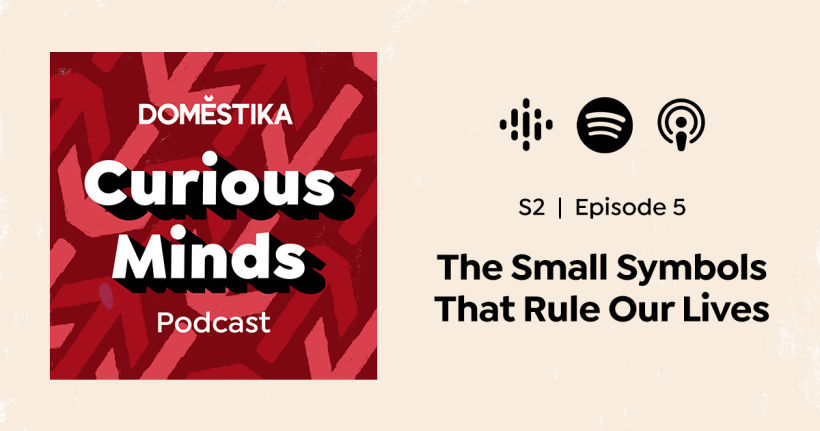Curious Minds Podcast S2: The Small Symbols That Rule Our Lives

How can simple symbols come together to help us navigate a complex world, and even transform it? This week, we’re talking about the pictogram
Curious Minds is an original podcast by Domestika that explores the curiosities and untold histories of the creative world. Every two weeks, we interview renowned creatives to discover the strange and fascinating stories behind different topics: like why stop motion endures in the digital age, or why we doodle.
Subscribe for free on Apple Podcasts, Spotify, or your favorite podcast app to never miss an episode.

You’ve arrived at an airport abroad, in a place where you don’t speak the language. It’s busy and loud, yet you know how to navigate this space to find the bathroom and baggage claim. How? Chances are, the answer is pictograms. Those little illustrations of simplified taxis, planes, bathrooms, and more. Bits of design that we take for granted because they're everywhere. But like any other language, pictograms evolve – and the ways designers are using them isn't just shaping our spaces, but also our conversations and culture.
So, how can simple stick figures say so much? And what do they have to say about the power of design?
In this episode, we examine the history, uses, styles, and implications of pictograms. We travel via the Isotype picture language developed in inter-war Vienna by Otto Neurath, through the “Tidyman” created by Budweiser in the fifties to discourage littering, to the ever-changing Olympic pictogram sets that accompany each Games.
Globalization has brought us all a lot closer together, but in a world full of different languages and cultures, it's pictograms that help us to communicate.
Click on the link below to listen and subscribe on Spotify. Alternatively, you can find the episode on Apple Podcasts, or wherever you get your podcasts. Scroll to the bottom of the post to download the episode transcript.
Season 2, Episode 5: The Small Symbols That Rule Our Lives
Our guests this week are Ashley Booth, Nick Ross, and Yang Liu.
Ashley Booth is a professor of Visual Communication, and was head of graphic design for the Lillehammer Olympic Committee in 1994. For her, pictograms are defined by their relations to each other: they are a “family” that share a design language and meaning. These “ubiquitous friends” help us to make sense of the world without words. We are directed, assisted, and warned by them. They are also instinctive—we draw stick figures from childhood, quickly understanding their core meanings.
For the 1994 Lillehammer Olympics, Booth and her team wanted to create a “festival” vibe that felt culturally Norwegian. She shares that “making [the pictograms] like rock carvings gave honor to our history.” The highly personal and emotive nature of pictograms may also be why they are so helpful to those who have experienced trauma. Booth is currently working on a project in Congo, helping women who have been sexually abused to express their stories using pictograms.
Nick Ross is a graphic designer at Gensler, a design justice practitioner, and a design equity advocate. He explains that, “all pictograms are symbols, but not all symbols are pictograms.” Symbols can be more abstract, while a pictogram is for a direct and clear use. Recently, he has worked on a project that reflects cultural shifts in gender, and the movement towards inclusive, neutral spaces. At San Francisco International Airport, Ross and his team worked on new signage for bathrooms. There was a balance to be struck: clarity and recognition of a new symbol being added to the general lexicon, with a sense of neutrality, safety, and nobody being singled out by the shift.
Finally, designer Yang Liu is the creator of East Meets West, the first of what would become a series of pictogram books. Reflecting her own experiences of having lived in China and Germany, each spread features a red and blue page. The red represents the East, the blue the West, and the pictograms shown on them break down cultural differences, like what counts as being punctual, how you should handle problems, or what the beauty standards are.
Yang points out that prehistoric discoveries of art often feature pictograms to communicate, and indeed many languages today are based on systems of forms used to depict ideas. In Chinese, for example, she notes that the character meaning “moon” still comes from the shape of the moon.
Pictograms give a voice in situations where words fail us. They can boost accessibility, shared understanding, and visual literacy. They are a symbol of how design never stops shifting, constantly interpreting and reinterpreting society.
Listen and subscribe to the Curious Minds podcast
Remember, to stay up to date with every episode, you can subscribe to Curious Minds for free on Apple Podcasts, Spotify, or your favorite podcast app.
Download the episode transcript:
If you'd like to discover more stories behind curiosities of the creative world we often take for granted, explore all the episodes from Curious Minds on our blog.
You may also like:
- How the Olympics Helped Popularize Pictograms
- What Is an Icon and How Does It Differ from a Pictogram?
- 10 Tips to Keep In Mind When Designing an Icon
- 5 Amazing Facts about Logos
- Pictogram Design for Brands, course by Wayfinding Consultores







0 comments